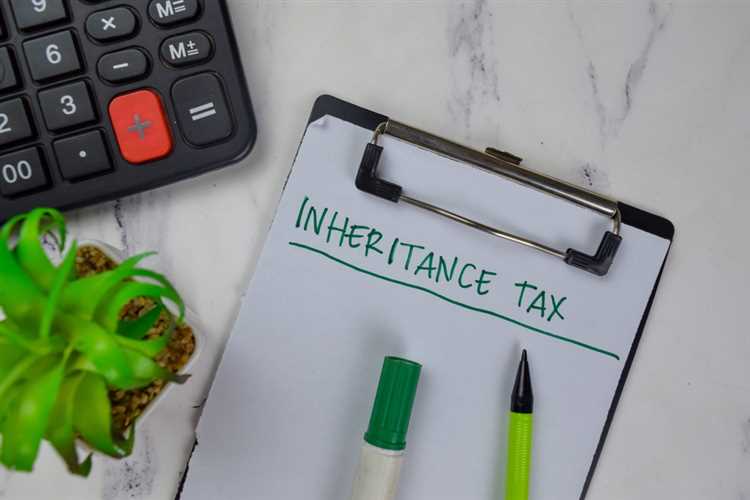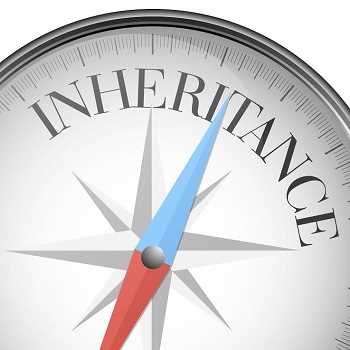- Overview of Ohio Inheritance Tax
- What is Ohio Inheritance Tax?
- Who is Subject to Ohio Inheritance Tax?
- How is Ohio Inheritance Tax Calculated?
- Changes to Ohio Inheritance Tax in 2022
- Recent Updates to Ohio Inheritance Tax Laws
- Impact of the Changes on Ohio Residents
- Question-answer:
- What is the Ohio inheritance tax?
- Who is responsible for paying the Ohio inheritance tax?
- What is the current inheritance tax rate in Ohio?
- Are there any exemptions to the Ohio inheritance tax?
- How can I calculate the Ohio inheritance tax I owe?
- What is the Ohio inheritance tax?
- Who is responsible for paying the Ohio inheritance tax?

When it comes to estate planning, understanding the intricacies of inheritance tax is crucial. In Ohio, the rules and regulations surrounding inheritance tax can be complex, and it’s important to stay informed to ensure your loved ones are protected.
What is inheritance tax?
Inheritance tax is a tax imposed on the assets and property that is passed down to beneficiaries after someone passes away. It is important to note that inheritance tax is different from estate tax, which is a tax on the total value of a person’s estate.
How does inheritance tax work in Ohio?
In Ohio, inheritance tax is determined based on the relationship between the deceased and the beneficiary. The tax rates vary depending on whether the beneficiary is a spouse, child, sibling, or other relative. Additionally, the value of the inheritance also plays a role in determining the tax rate.
For example, spouses and lineal descendants (children, grandchildren, etc.) are exempt from inheritance tax in Ohio. However, siblings are subject to a tax rate of 6% on inheritances over $100,000.
Important changes for 2022
It’s important to stay up to date with any changes to inheritance tax laws, as they can have a significant impact on your estate planning. As of 2022, Ohio has not made any major changes to its inheritance tax laws. However, it’s always a good idea to consult with a qualified estate planning attorney to ensure you have the most accurate and current information.
Remember, proper estate planning can help minimize the impact of inheritance tax on your loved ones. By understanding the Ohio inheritance tax laws and working with a knowledgeable professional, you can ensure that your assets are distributed according to your wishes.
Overview of Ohio Inheritance Tax
The Ohio Inheritance Tax is a tax imposed on the transfer of property from a deceased person to their beneficiaries. It is important for Ohio residents to understand this tax and its implications, as it can have a significant impact on their estate planning and the distribution of their assets.
What is Ohio Inheritance Tax?
The Ohio Inheritance Tax is a state-level tax that is imposed on the transfer of property upon the death of a resident. It is separate from the federal estate tax, which is imposed on the transfer of property at the federal level. The Ohio Inheritance Tax is based on the value of the property transferred and is calculated using a progressive tax rate schedule.
Who is Subject to Ohio Inheritance Tax?
Not all estates are subject to the Ohio Inheritance Tax. The tax only applies to estates with a total value exceeding a certain threshold, which is currently set at $338,333 for deaths occurring in 2022. If the total value of the estate is below this threshold, no inheritance tax is due. However, if the estate exceeds the threshold, the tax is imposed on the value of the property transferred to each beneficiary.
How is Ohio Inheritance Tax Calculated?
The Ohio Inheritance Tax is calculated using a progressive tax rate schedule. The tax rates range from 1% to 7% and increase as the value of the property transferred increases. The tax is imposed on the net value of the property transferred, which is determined by subtracting any debts, funeral expenses, and administrative expenses from the total value of the estate.
Changes to Ohio Inheritance Tax in 2022
There have been recent updates to the Ohio Inheritance Tax laws that Ohio residents should be aware of. In 2022, the threshold for the tax has increased to $338,333, up from $217,000 in 2021. This means that estates with a total value below $338,333 are not subject to the tax. Additionally, the tax rates have been adjusted to reflect the changes in the federal estate tax exemption.
Impact of the Changes on Ohio Residents
The changes to the Ohio Inheritance Tax laws in 2022 have provided some relief for Ohio residents. With the increased threshold, more estates will be exempt from the tax, allowing beneficiaries to receive a larger portion of the estate. However, it is still important for Ohio residents to carefully consider their estate planning and consult with a qualified professional to ensure that their assets are distributed in the most tax-efficient manner.
What is Ohio Inheritance Tax?
The Ohio Inheritance Tax is a tax imposed on the transfer of property from a deceased person to their beneficiaries. It is a state-level tax that is separate from the federal estate tax. The tax is based on the value of the property being transferred and is paid by the beneficiaries.
The purpose of the Ohio Inheritance Tax is to generate revenue for the state and to ensure that the transfer of wealth is taxed fairly. The tax rates vary depending on the relationship between the deceased person and the beneficiary. Close relatives, such as spouses and children, generally have lower tax rates compared to more distant relatives or non-relatives.
The Ohio Inheritance Tax applies to both residents and non-residents of Ohio. If the deceased person owned property in Ohio, the tax will be imposed on the transfer of that property, regardless of where the beneficiary resides. However, if the deceased person was a resident of Ohio, the tax will be imposed on the transfer of all their property, regardless of its location.
It is important to note that not all property is subject to the Ohio Inheritance Tax. Certain types of property, such as life insurance proceeds, retirement accounts, and property held in a trust, may be exempt from the tax. Additionally, there are certain deductions and credits available that can reduce the amount of tax owed.
| Relationship to Deceased | Tax Rate |
|---|---|
| Spouse | 0% |
| Children and grandchildren | 0% |
| Siblings | 1% |
| Other relatives | 4.5% |
| Non-relatives | 6% |
The Ohio Inheritance Tax is administered by the Ohio Department of Taxation. The executor of the deceased person’s estate is responsible for filing the necessary tax returns and paying the tax. Failure to comply with the tax laws can result in penalties and interest.
It is recommended to consult with a qualified tax professional or attorney to ensure compliance with the Ohio Inheritance Tax laws and to explore any available deductions or credits that may reduce the tax liability.
Who is Subject to Ohio Inheritance Tax?
In Ohio, the inheritance tax is imposed on the transfer of property from a deceased person to their beneficiaries. However, not all beneficiaries are subject to this tax. The Ohio inheritance tax applies only to certain individuals who receive property from the deceased person’s estate.
The following individuals are subject to Ohio inheritance tax:
- Class A Beneficiaries: This includes the deceased person’s spouse, parents, grandparents, and children (including adopted and stepchildren).
- Class B Beneficiaries: This includes the deceased person’s siblings and their descendants.
- Class C Beneficiaries: This includes all other individuals who are not classified as Class A or Class B beneficiaries.
It’s important to note that the tax rates and exemptions vary depending on the relationship between the deceased person and the beneficiary. Class A beneficiaries generally have lower tax rates and higher exemptions compared to Class B and Class C beneficiaries.
Additionally, certain types of property are exempt from Ohio inheritance tax, such as property passing to a surviving spouse or property passing to a charitable organization.
If you are unsure whether you are subject to Ohio inheritance tax, it is recommended to consult with a qualified tax professional or attorney who can provide personalized guidance based on your specific situation.
How is Ohio Inheritance Tax Calculated?
The calculation of Ohio Inheritance Tax is based on the value of the assets that are being inherited. The tax rates vary depending on the relationship between the deceased person and the beneficiary. Ohio has a progressive tax system, which means that the tax rates increase as the value of the inherited assets increases.
For Class A beneficiaries, which include spouses, parents, and children, the tax rates range from 0% to 7%. The tax is not imposed on the first $25,000 of the inherited assets, and the rate gradually increases from 1% to 7% for assets over $500,000.
For Class B beneficiaries, which include siblings and other lineal descendants, the tax rates range from 0% to 13%. The tax is not imposed on the first $500 of the inherited assets, and the rate gradually increases from 1% to 13% for assets over $25,000.
For Class C beneficiaries, which include all other individuals and organizations, the tax rates range from 0% to 16%. The tax is not imposed on the first $1,000 of the inherited assets, and the rate gradually increases from 1% to 16% for assets over $5,000.
It is important to note that Ohio has a unified tax system, which means that the tax rates apply to the total value of the inherited assets, not to each individual beneficiary. This means that if there are multiple beneficiaries, the tax will be calculated based on the combined value of the assets they are inheriting.
In addition to the tax rates, there are also certain deductions and exemptions that can reduce the amount of Ohio Inheritance Tax owed. These include deductions for funeral expenses, debts of the deceased person, and charitable bequests. There is also a $13,000 exemption for Class A beneficiaries and a $500 exemption for Class B and Class C beneficiaries.
Overall, the calculation of Ohio Inheritance Tax can be complex, and it is recommended to consult with a tax professional or attorney to ensure compliance with the state’s tax laws and to determine the exact amount of tax owed.
Changes to Ohio Inheritance Tax in 2022
Ohio has made significant changes to its inheritance tax laws in 2022, affecting how estates are taxed and who is subject to the tax. These changes aim to simplify the tax system and provide relief to Ohio residents.
Elimination of Inheritance Tax for Most Beneficiaries:
One of the major changes is the elimination of inheritance tax for most beneficiaries. Previously, Ohio imposed a tax on inheritances received by individuals who were not immediate family members, such as friends or distant relatives. However, starting in 2022, this tax has been eliminated for most beneficiaries, providing them with significant tax relief.
Increased Exemption Amount:
Another important change is the increase in the exemption amount for immediate family members. Immediate family members, including spouses, children, and grandchildren, now have a higher exemption threshold before they are subject to inheritance tax. This means that more assets can be passed down to immediate family members without incurring any tax liability.
Gradual Phase-Out of Inheritance Tax:
Ohio has also implemented a gradual phase-out of the inheritance tax over the next few years. This means that the tax rates will gradually decrease until the tax is completely eliminated. This phased approach provides a smooth transition for taxpayers and allows them to plan their estates accordingly.
Impact on Ohio Residents:
These changes to the Ohio inheritance tax have a significant impact on Ohio residents. The elimination of the tax for most beneficiaries and the increased exemption amount provide relief to individuals who would have otherwise been subject to the tax. This allows Ohio residents to pass down their assets to their loved ones without the burden of a hefty tax bill.
Recent Updates to Ohio Inheritance Tax Laws
Ohio has recently made significant updates to its inheritance tax laws, which have important implications for residents of the state. These changes aim to simplify the tax system and provide relief to taxpayers.
One of the key updates is the increase in the exemption threshold for Ohio inheritance tax. Previously, estates valued at $5 million or less were exempt from the tax. However, under the new laws, estates valued at $10 million or less are now exempt. This means that more individuals will be able to pass on their assets to their heirs without incurring any inheritance tax.
In addition to the increase in the exemption threshold, Ohio has also eliminated the graduated tax rates that were previously applied to taxable estates. Instead, a flat tax rate of 3% will now be applied to all taxable estates. This simplification of the tax rate structure will make it easier for taxpayers to calculate their inheritance tax liability.
Furthermore, the new laws have introduced a provision that allows for the deduction of certain expenses from the taxable estate. These expenses include funeral and burial expenses, as well as administrative expenses related to the settlement of the estate. This deduction can help reduce the overall tax liability for the estate.
It is important to note that these updates to Ohio inheritance tax laws only apply to estates of individuals who pass away on or after January 1, 2022. Estates of individuals who passed away prior to this date will still be subject to the previous tax laws.
Overall, the recent updates to Ohio inheritance tax laws aim to provide relief to taxpayers and simplify the tax system. By increasing the exemption threshold, implementing a flat tax rate, and allowing for certain deductions, Ohio is making it easier for individuals to pass on their assets to their heirs without incurring a significant tax burden.
| Previous Tax Laws | New Tax Laws |
|---|---|
| Estates valued at $5 million or less were exempt from inheritance tax. | Estates valued at $10 million or less are now exempt from inheritance tax. |
| Graduated tax rates were applied to taxable estates. | A flat tax rate of 3% is now applied to all taxable estates. |
| No provision for deduction of certain expenses. | Expenses such as funeral and burial expenses, as well as administrative expenses, can now be deducted from the taxable estate. |
Impact of the Changes on Ohio Residents
The changes to Ohio inheritance tax laws in 2022 have significant implications for Ohio residents. These changes aim to simplify the tax system and provide relief to taxpayers.
One of the key changes is the increase in the exemption threshold. Previously, Ohio residents were subject to inheritance tax on estates valued at $25,000 or more. However, starting in 2022, the exemption threshold has been raised to $100,000. This means that estates valued below $100,000 are now exempt from Ohio inheritance tax.
This change is particularly beneficial for middle-class families who may have previously been subject to inheritance tax. With the higher exemption threshold, more Ohio residents will be able to pass on their assets to their loved ones without incurring a tax burden.
Another important change is the elimination of the sibling exemption. Previously, siblings were exempt from inheritance tax on estates valued at $20,000 or less. However, this exemption has been removed in 2022. Now, siblings will be subject to the same inheritance tax rates as other beneficiaries.
Additionally, the changes to Ohio inheritance tax laws have simplified the tax rates. Previously, the tax rates ranged from 1% to 7% depending on the value of the estate. However, starting in 2022, a flat tax rate of 3% will be applied to all taxable estates. This simplification of the tax rates makes it easier for Ohio residents to understand and calculate their potential tax liability.
Overall, the changes to Ohio inheritance tax laws in 2022 have a positive impact on Ohio residents. The higher exemption threshold, elimination of the sibling exemption, and simplified tax rates provide relief to taxpayers and make the tax system more fair and transparent. Ohio residents can now plan their estates with greater certainty and ensure that their assets are passed on to their loved ones without unnecessary tax burdens.
Question-answer:
What is the Ohio inheritance tax?
The Ohio inheritance tax is a tax imposed on the transfer of assets from a deceased person to their beneficiaries.
Who is responsible for paying the Ohio inheritance tax?
The responsibility for paying the Ohio inheritance tax falls on the beneficiaries who receive the assets from the deceased person’s estate.
What is the current inheritance tax rate in Ohio?
The current inheritance tax rate in Ohio varies depending on the relationship between the deceased person and the beneficiary. It can range from 0% to 7%.
Are there any exemptions to the Ohio inheritance tax?
Yes, there are certain exemptions to the Ohio inheritance tax. For example, spouses and charitable organizations are exempt from paying the tax.
How can I calculate the Ohio inheritance tax I owe?
To calculate the Ohio inheritance tax you owe, you will need to determine the value of the assets you received and apply the appropriate tax rate based on your relationship to the deceased person. It is recommended to consult with a tax professional for accurate calculations.
What is the Ohio inheritance tax?
The Ohio inheritance tax is a tax imposed on the transfer of assets from a deceased person to their beneficiaries. It is based on the value of the assets received by each beneficiary.
Who is responsible for paying the Ohio inheritance tax?
The responsibility for paying the Ohio inheritance tax falls on the beneficiaries who receive assets from the deceased person’s estate. The executor of the estate is responsible for filing the tax return and ensuring that the tax is paid.






